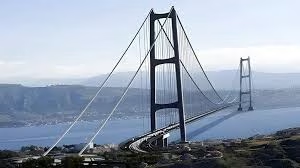Read also: Julsundet crossing, one of the world‘s longest suspension bridges to be constructed in Norway
A Bridge Centuries in the Making
Back, in 2006 a consortium led by the Salini Impregilo, now known as WeBuild was granted the contract to construct the bridge. However, when Berlusconis government fell that year the bridge project was abandoned under the Prime Minister Romano Prodi, who considered it both costly and environmentally risky.
“After witnessing the construction of various ‘Messina Style’ bridges, across the globe, Pietro Ciucci, the CEO of Stretto di Messina SpA (SdM) a state owned project sponsor believes that it is now the moment to embark on building one over the Strait of Messina.
The proposed bridge will feature three lanes for vehicles in each direction along with a lane designated for rail transport. Its deck is planned to accommodate a 1,970 ft navigation channel with a generous 215 ft of clearance above. Designed with a profile of withstanding winds reaching speeds of up to 180 mph and resilient enough to endure earthquakes measuring up, to 7.1 on the Richter scale.”
For nearly 2,000 years, the idea of constructing a bridge across the Messina Strait has tantalized the imagination. The Romans toyed with the concept, envisioning a floating pontoon bridge supported by interconnected barrels. However, this ambitious plan never came to fruition. Over the centuries, numerous other proposals emerged, only to be met with rejection. With each passing era, the pace of these suggestions has quickened, spurred on by advancements in construction technology.

Messina Strait bridge-World’s longest suspension bridge
At the time the bridge design was approved, government official Longo informed Parliament that construction across the Strait of Messina would begin promptly once the updated contract was finalized. He noted that the detailed design phase was expected to last eight months, followed by a construction period of more than six years.
Public records, from the treasury department reveal that 1.2B euros ($1.3B) have already been allocated for feasibility studies since 1965. Salvini often emphasizes that the cost of not constructing the bridge could outweigh the expenses associated with its construction.”
The Strait of Messina lies along a fault line where a powerful 7.1 magnitude earthquake occurred in 1908. Claiming, over 100,000 lives and triggering tsunamis that caused damage to the regions on both the Calabrian and Sicilian sides of the strait. This event stands as the occurrence ever recorded in Europe.
The waters in this area are known for their turbulence. Strong currents often dislodge seaweed from the seabed with their direction changing every six hours as observed by NASA. These dynamic wave patterns are even visible from space.
WeBuilds proposal
As per WeBuilds proposal, which’s currently the sole plan being considered due to pending bids the bridge deck would be constructed to withstand wind speeds of up to 300 kilometers per hour. The structure could remain open for traffic when facing winds reaching up to 150 kilometers, per hour.
The Messina Strait bridge (world’s longest suspension bridge), will be 74 meters above sea level. Additionally, it will have a navigation channel width of 600 meters to accommodate vessels, including large cargo ships and towering cruise liners. Additionally, it is being engineered to withstand activity up, to a magnitude of 7.5.
Previous official statement from Webuild CEO
The most recent official statement from Webuild CEO Pietro Salini was made on March 14, 2025, when he confirmed that construction of the Messina Strait Bridge was scheduled to begin by the end of April, with completion expected by 2032. While work has not yet started, Infrastructure Minister Matteo Salvini has since assured that construction is now just a matter of weeks away. Salini had emphasized Webuild’s full readiness and highlighted the project’s importance, especially for southern Italy.
In a statement released on January 29, 2025, Webuild CEO Pietro Salini reiterated the company’s readiness to undertake the construction of the Messina Strait Bridge. Highlighting their proven expertise and unwavering commitment to safety and legal compliance. The decision to build the Messina Strait Bridge is a political one—it has nothing to do with engineering feasibility,” Salini stated. “As a group, alongside our supply chain, we possess all the technical and technological capabilities needed to build the bridge safely, reliably, and in full respect of the law. We prove this every day through the complex infrastructure we deliver both in Italy and around the world.”
He emphasized that the bridge is structurally viable, even in the earthquake-prone Strait of Messina, and stressed that its realization depends solely on political will.

Read also: Europe’s Largest Green Bridges and UK’s Longest Road Tunnel Included in Kent Roads Contract
Construction phase
During the construction phase, an estimated 2.9B euros would be injected into the economy. Providing employment for around 100,000 individuals and involving the collaboration of 300 suppliers. Longo mentioned in parliament that a significant portion of these job opportunities would be targeted towards residents. From Sicily and Calabria regions, where unemployment rates are notably high.
Salvini adamantly argues that the economic impact following the construction of the bridge would undoubtedly be substantial. He suggests that cargo ships originating from Asia could conveniently dock in Sicily. With the goods then seamlessly transported via high-speed trains to Europe. However, it’s worth noting that such high-speed rail networks on Sicily are currently non-existent.
Read also: The longest bridge in the world
Project Fact Sheet: Messina Strait Bridge
Name: Messina Strait Bridge
Estimated Cost: €13.5 billion ($15.6 billion)
Design Features:
Length: 3,666 metres (12,028 ft);
Design: Suspension
Navigation Channel: 1,970 feet with 215 feet of clearance
Wind Resistance: Designed to withstand winds up to 180 mph
Earthquake Resistance: Engineered to endure quakes up to 7.5 on the Richter scale
Height:</strong> 382.6 metres (1,255 ft)
Navigation Channel Width: 600 meters
Italy has designated the project as a national priority, allocating €13.5 billion ($15.63 billion) over the next decade for the construction of the bridge and related infrastructure.
The Interministerial Committee for Economic Planning and Sustainable Development (CIPESS) approved the plan during a meeting in Rome. Clearing the way for construction to begin. According to the Messina Strait Company, the bridge connecting to Sicily—home to 4.7 million people—is expected to be completed by 2032.


